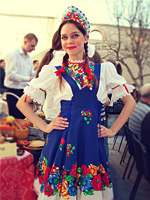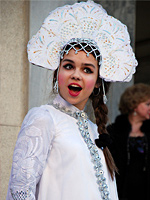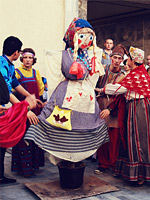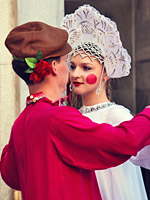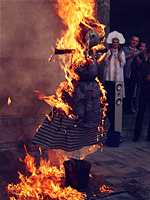8th of March- Women Day .
International Women's Day -The 8-th of March! Tt's one of most important
holidays in Russia. The celebration is similar to a combination between
Valentine's Day and
Mother's Day in the West but better. This is a national holiday and a day off. Several nations celebrate this, but only a few acknowledge it as an official, non-working holiday .
If you forgot to send a rose on Valentine's Day, it's only half the trouble. But if you forgot to send a rose to your lady, her/your mother, her/your sister and her/your daughter on the 8th of March, you are in a really big trouble! Women's Day Gift Ideas!
At this day All Russian Men traditionally congratulate All Women in their lives (their mothers, wives, daughters, grandmothers, girl-friends, teachers...) with first spring flowers: pink, mimosa, and tulips, candy and cards with self-made short poems. Every Woman of any age has present on this day, all women are honored! At this day Russian women are surrounded with flowers, love, and poems and caress . She doesn't aloud to do anything in house at that day: men's do all cooking, cleaning…. The Women Day - 8th of March is the best holyday for Russian women of any age.
I some way the history of this holyday is connected with ancient Rome. There was a special Women day for noble women. All free borne women, who were married, got presents from their husbands at this day. They were surrounded by love and attention.But even slaves women had not work at that day. Rome women visited temple of Divinity Vestal, who was a keeper of home hearth.
Today Many Russian women appreciate the extra attention at this day , but at the same time the holiday highlights the lack of rights and respect many women receive, both at home and the workplace and not only in russia but all over the world .
Lets take a look at history of International Women's Day:
At 8-th of March 1857 American women - textile workers of New York City held a demonstration over town streets. They were protesting against the low earnings and bad trade conditions.
At 19 century , women began to defend for their human rights. Strong gender segregation and a small percentage of employed women in industrially developed countries marked the years prior to the historical 1910. Those who were employed worked exclusively in the textile industry, manufacture, and as service staff in households. They worked in very bad conditions, and for extremely small pay. At the same time, great crises repeatedly strike the industry. Women workers' coalitions, which did not belong to the trade unions, found themselves in an unenviable position, while the unions gained more and more strength. In Europe, Great Britain, America, and to a lesser extent Australia, women lobby ever more for their suffrage. This struggle seemed as if it suppressed all other aspects of women's lives, and new, revolutionary changes were getting a visible shape.
1903, USA - Trade unions and independent women's associations also supporting women's suffrage, founded the Women's Trade Union League, in order to help women workers to gain political and economic strength. It was still a time of hard work conditions and poverty.
1908, USA - Last Sunday in the February of 1908, American women socialists marked the first Women's Day, by organizing large demonstrations. They demand not only suffrage for women, but also the realization of their political and economic rights. Next year, 2.000 people participated in the demonstrations on Manhattan.
1909, USA - This year, the women workers of textile industry organized a general strike. Around 30.000 women workers went on strike for 13 weeks. They demanded better pay and better work conditions. The Women's Trade Union League paid bail for the arrested, and financially helped the strikers' fund.
1910, USA - The Women's Day was accepted by women socialists and feminists all over the USA
1910, Copenhagen - The delegation from the Trade Unions is present at the Second International Conference of Women Socialists in Copenhagen, with the intention of suggesting that Women's Day be made an international holiday.
Clara Cetkin from German Socialist Party - a strong advocate of women's suffrage, had a great influence over the international socialist movement. Clara Cetkin incited by the happenings and the actions of American women workers, shaped the demand for marking a single day in a year, when women would lobby for their interests. Over a hundred women from 17 countries attended the Conference, representing trade unions, socialist parties, women workers' clubs. As the result the suggestion of Clara Cetkin was accepted unanimously, of the marking the Women's Day. On the conference, the importance of women's suffrage was once again confirmed: the right to vote, which would not be based on the rights of property. Namely, some socialists held that women's suffrage would easier be attained through realizing rights of ownership, while others, including theGerman activist - Clara Cetkin, and the Russian activist - Alexandra Kollontai, fought for the realization of this right as a obligatory and separate part of the socialist program. A universal suffrage was also demanded - for all adult women and men. One of the conclusions of the conference was also to proclaim work at night as dangerous for women's health. Workers from Sweden and Denmark opposed this, for, as they stated, it was work during night shift that was an irreplaceable source of income. It was also demanded that the rights of married mothers be made equal to those of single mothers, for which Alexandra Kollontai fought vigorously, but her efforts did not give results.
1911 - As a result of the decisions made in Copenhagen, the Women's day was first marked on the 19th of March, in Austria, Denmark, Germany and Switzerland. More than a million women and men celebrated it. They demanded not only women's suffrage, but also making the right to work possible, professional improving, and abolishing sexual discrimination.
On the 25th of March 1911 in New York, more than 14 women workers, mostly Italian and Jewish immigrants, were killed in a tragic fire . The accident, which was the consequence of bad work conditions, would be a powerful influence on the labor legislation in the United States of America.
1913-1914, Russia - As part of the pacifist movement, which started its activities in the eve of the First World War, Russian women marked the Women's Day for the first time, on the last Sunday of February 1913. Elsewhere in Europe, the Women's Day was celebrated on, or around, the 8th of March, either as an antiwar protest, or as an expression of solidarity with the women of Russia.
1917, Russia - 2 million Russian soldiers dead in the war. Once again, Russian women chose the last Sunday of February to mark Women's day, and demand rights to "bread and peace". The political top of Russia opposed the timing of the strike, but the women went on anyway …
Four days later, the Russian Tsar abdicated, and the temporary government guaranteed women the right to vote. This historical Sunday, according to the Julian calendar, which was at that time in use in Russia, went on the 23rd of February, and according to the otherwise used Gregorian calendar, on the 8th of March. It was taken as the day when the entire world will mark the international holiday - Women's Day. Women and women's organizations around the world mark Women's Day, and many countries have it for a national holiday So as you see Russia celebrates Women Day from 1913 till nowadays.
As you see The 8th of March is typically celebration of feminist and women's rights groups. But at the meanwhile, as life in Russia is different from that in the USA in many ways the 8th of March is one of most favorite holiday for all Russian women and along with New Year and Christmas and Valentine's Day it is also one of most romantic holiday. For Russian Women the- 8 of March "Women day" a real holyday of Love and Spring.




